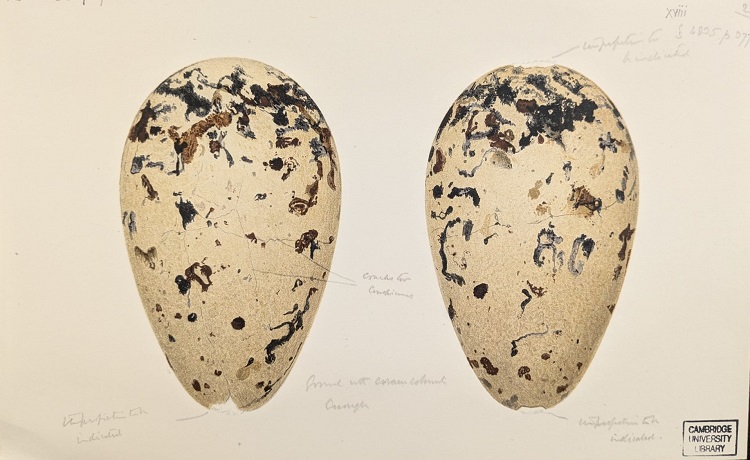
Archives and Modern Manuscripts Image of the Month: John Wolley’s great auk egg
In 1858 two ornithologists, John Wolley and Alfred Newton, travelled to Iceland in the hope of seeing a flightless seabird, the elusive great auk. Both men had been keen on nature, and specifically birds, from an early age. Wolley graduated from Cambridge with a BA in 1846, and studied medicine at Edinburgh University, but had foregone a medical career to concentrate on ornithology. He became an avid egg collector, illegal now, but a popular pastime in Victorian Britain carried out by both hobbyists and serious ornithologists alike.
Wolley travelled extensively in his quest, especially in Scandinavia and Russia, and would go on to amass a collection of over 10000 eggs. During his travels he corresponded with other naturalists, and his lively letters to Alfred Newton sent from the far North led to them becoming friends. Newton had also studied at Cambridge, and in 1853 was awarded the University’s Drury Travelling Fellowship, allowing him to travel the world for ten years, developing his ornithological interest and, like Wolley, collecting eggs.
Very much like ‘twitchers’ of today, the two men were keen on seeing rarities, and they became obsessed with finding the rarest of them all, the legendary great auk. The great auk was a flight-less bird of the Northern Atlantic, breeding on rocky remote islands. Hunted for food, fish bait and it’s soft down, by 1800 its numbers had dwindled and sightings of the bird became rare, with a few islands off the coast of Iceland being their last known nesting site. Two auks had been killed on the island of Eldey in 1844, and there had been a supposed sighting in 1852. Wolley and Newton realised that they would have to be quick if they were to have a sighting of the bird. Travelling to Iceland, they hoped to visit Eldey, but their plans were thwarted by bad weather, and they spent their time in Iceland collecting information about the auk from fisherman and other locals. Returning to England, they would never realise their dream. 1844 was the last confirmed sighting of the great auk and in 1869 Newton finally concluded that the bird belonged to the past. His research into its disappearance would lead him to develope the concept of extinction as we now know it, thus paving the way for environmental protection measures which we have today. Newton himself was instrumental in bringing forward The Sea Birds Preservation Act which made it illegal to hunt sea birds between April and August.
Wolley tragically died soon after returning from Iceland, but he did manage to acquire a great auk egg, much sought after because of their size and beauty, whilst Newton would eventually own seven. Wolley bequeathed his egg collection to Newton and he undertook their cataloguing, taking forty years to complete the four volume Ootheca Wolleyana. The illustration by Henrik Grunwald of Wolley’s great auk egg, a draft of which is shown above, featured as a plate in the catalogue. The egg collection now resides in the Museum of Zoology in Cambridge.
The papers of Alfred Newton in the Archives and Modern Manuscripts collections at Cambridge University Library has a section on the great auk. This includes the five volume Gare-Fowl Books which Wolley started whilst on the Iceland trip, full of information on the great auk and descriptions of their visit. Also included in the collection are illustrations, notes, newspaper cuttings and copies of articles.

